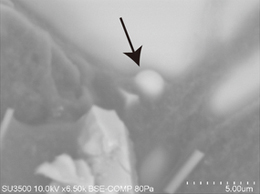Research Abstract
福島原子力発電所事故の初期段階に放出されたセシウムを含む球状粒子
Emission of spherical cesium-bearing particles from an early stage of the Fukushima nuclear accident
2013年8月30日 Scientific Reports 3 : 2554 doi: 10.1038/srep02554

福島原子力発電所事故によって、2011年3月に北半球全体にわたって環境中へ放射性物質が放出され、日本政府は、多額の資金を費やして汚染された住宅地域や農地を除染している。しかし、放出された放射性物質の正確な物理的性質や化学的性質はまだ分かっていない。本論文では、事故の比較的初期段階(3月14~15日)に放出されたCsを含む球状粒子を直接観察した。一般に考えられているCsを含む放射性物質と比べて、この粒子は、より大きく、Fe、Zn、Csを含み、水に溶けない。我々のシミュレーションは、このCsを含む球状粒子が主に乾性沈着によって地表に降下したことを示している。今回の球状Cs粒子の発見は、事故の過程を解明し、健康への影響と環境中の滞留時間を正確に評価するのに重要になるだろう。
足立 光司1, 梶野 瑞王1, 財前 祐二1 & 五十嵐 康人1
- 気象研究所
The Fukushima nuclear accident released radioactive materials into the environment over the entire Northern Hemisphere in March 2011, and the Japanese government is spending large amounts of money to clean up the contaminated residential areas and agricultural fields. However, we still do not know the exact physical and chemical properties of the radioactive materials. This study directly observed spherical Cs-bearing particles emitted during a relatively early stage (March 14–15) of the accident. In contrast to the Cs-bearing radioactive materials that are currently assumed, these particles are larger, contain Fe, Zn, and Cs, and are water insoluble. Our simulation indicates that the spherical Cs-bearing particles mainly fell onto the ground by dry deposition. The finding of the spherical Cs particles will be a key to understand the processes of the accident and to accurately evaluate the health impacts and the residence time in the environment.

